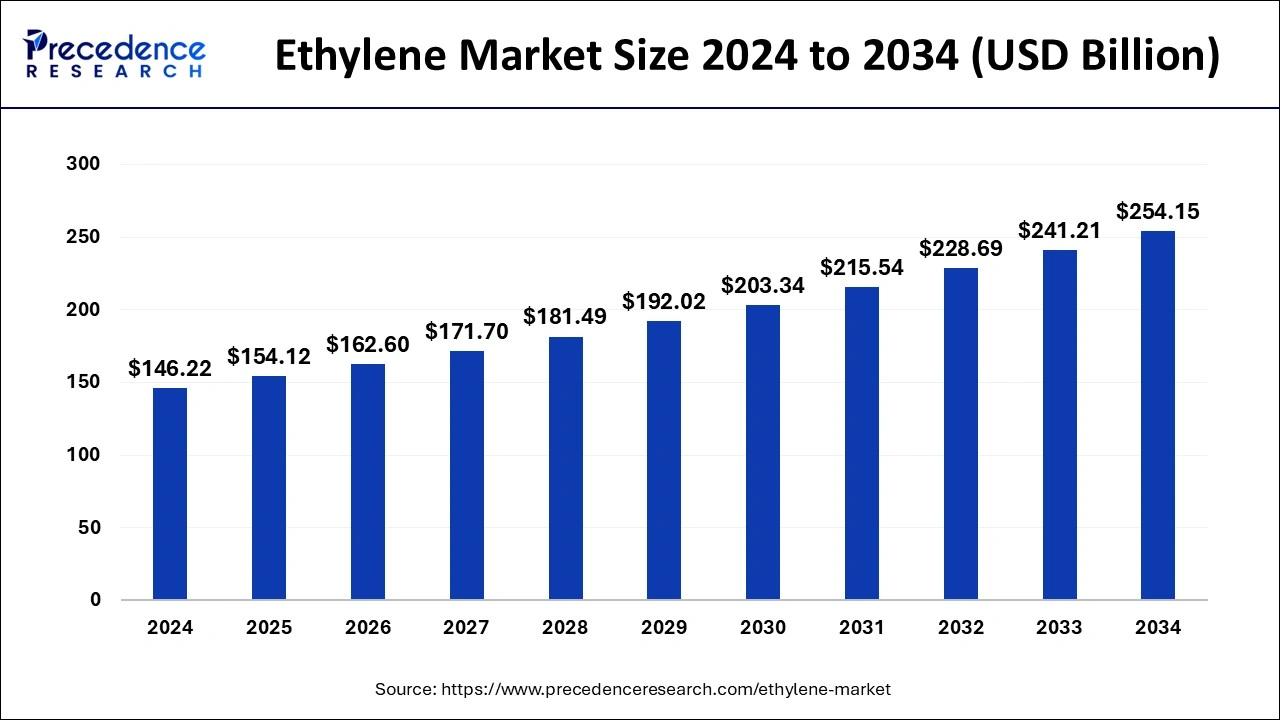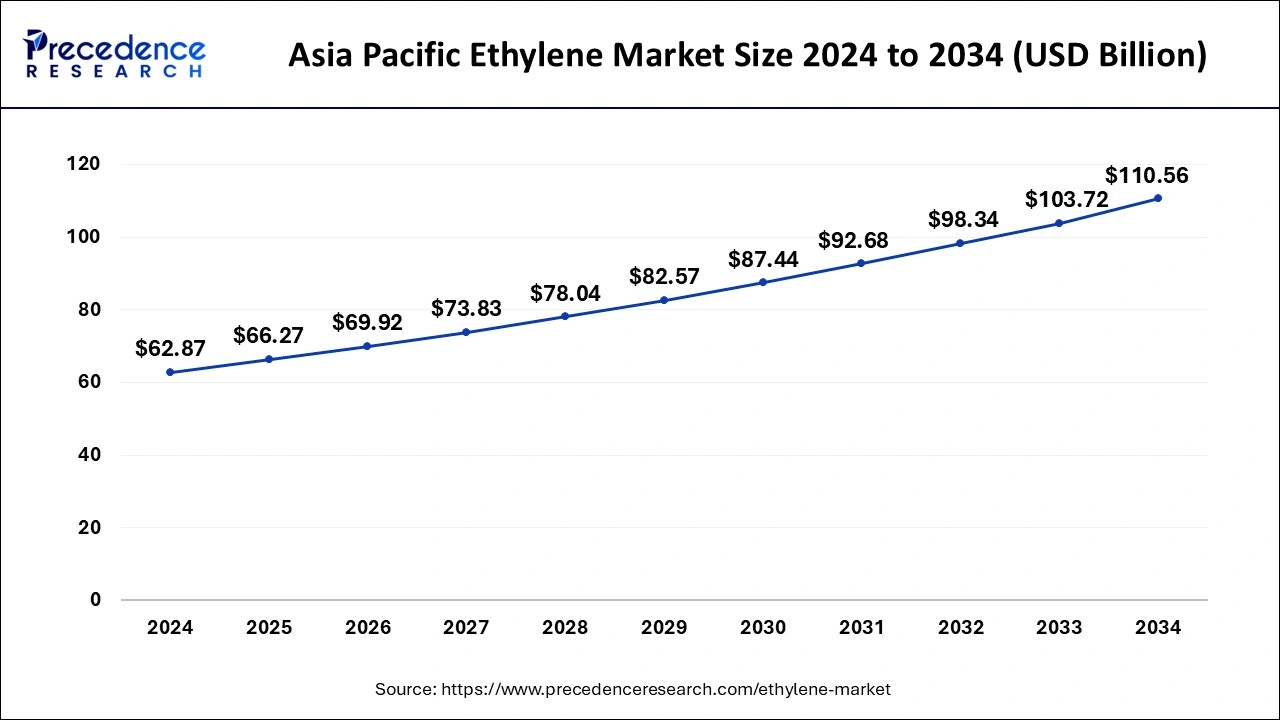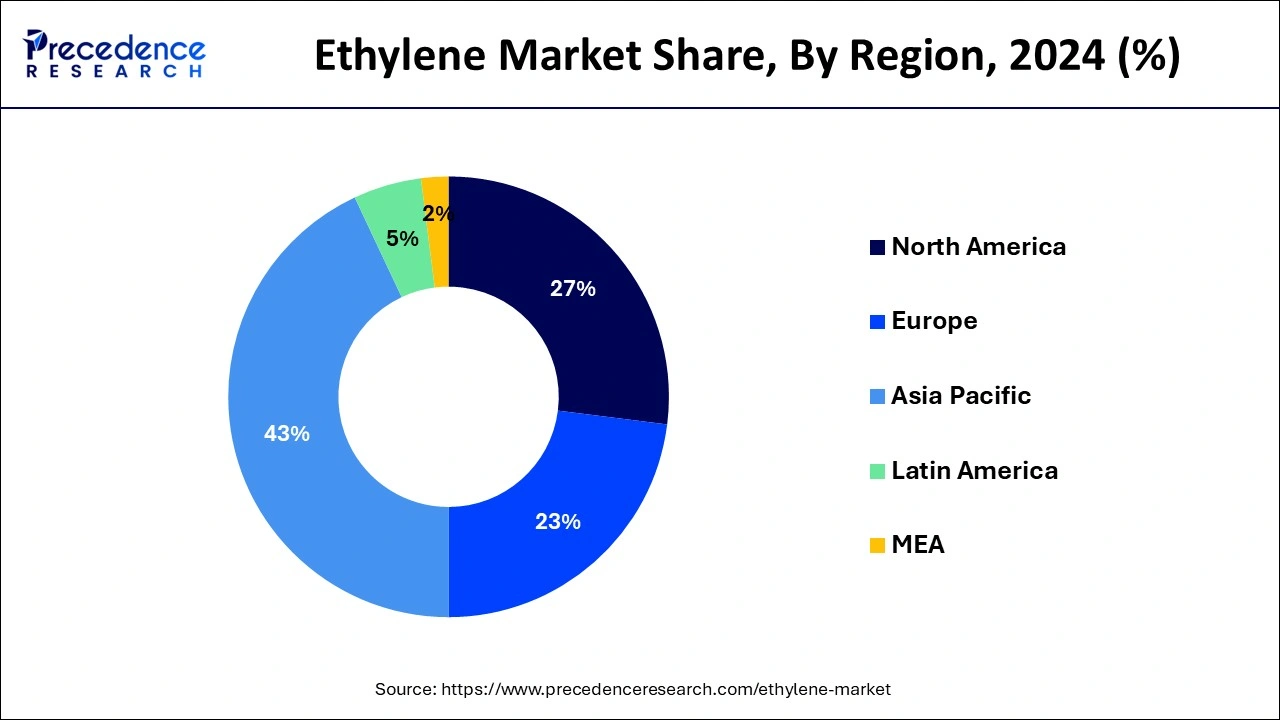August 2024
The global ethylene market size is calculated at USD 154.12 billion in 2025 and is forecasted to reach around USD 254.15 billion by 2034, accelerating at a CAGR of 5.68% from 2025 to 2034. The Asia Pacific ethylene market size surpassed USD 66.27 billion in 2025 and is expanding at a CAGR of 5.81% during the forecast period. The market sizing and forecasts are revenue-based (USD Million/Billion), with 2024 as the base year.
The global ethylene market size was exhibited at USD 146.22 billion in 2024 and it is projected to surpass around USD 254.15 billion by 2034, anticipated to reach a registered CAGR of 5.68% during the forecast period 2025 to 2034.

The Asia Pacific ethylene market size reached USD 62.87 billion in 2024 and is anticipated to be worth around USD 110.56 billion by 2034, poised to grow at a CAGR of 5.81% from 2025 to 2034.

The Asia-Pacific accounted for 43% revenue share in 2024. Positive economic and demographic trends, rising demand for petrochemical derivatives, and other factors have all contributed to the market's revenue growth. The availability of conventional feedstock and the rising expansion capacities of industry participants are additional significant variables boosting market revenue development. The need for ethylene-based derivatives in end-use sectors including packaging, automotive, and construction dominates this industry. Due to the expansion of the manufacturing sector in nations like China, India, and Japan, the region will continue to dominate the worldwide market over the projection period.

North America had a 27% revenue share in 2024 and is anticipated to grow at a quicker CAGR than the rest of the world over the projected period. The United States demand for ethylene is anticipated to rise as a result of expanding shale oil output, strong automotive sales, an uptick in building activity, and a booming flexible packaging sector. In addition, the expansion of the region's ethylene production, increased demand for plastics and basic chemicals, and technological developments will all contribute to an increase in market revenue.
The third-largest revenue share in 2023 came from Europe. Public and private investment in this region has increased as a result of Europe's ongoing growth in the construction and packaging sectors. The growth engine for the European construction sector may also change from end-use industries like packaging, construction, and automotive, among others. Product demand in this area is being driven by rising spending on residential, non-residential, and civil engineering operations in many European Union (EU) countries, including Germany, the U.K., and France, among others.
The size of the ethylene market will increase through 2023 as a result of rising expenditures meant to increase the production capacity for gas. The widespread use of ethylene in sectors including packaging, buildings, and automobiles will further increase demand for ethylene internationally. The demand for ethylene has increased globally, but mainly in the Asia-Pacific area due to the increasing number of goods made using various types of polyethylene, such as linear low-density polyethylene and high-density polyethylene. It is projected that the rapidly shifting consumer preference toward bio-based products will have an impact on the expansion of the ethylene industry. As a result, the demand for processed food and beverages has increased, acting as a major factor favoring the market's growth over the anticipated period. This is related to the sudden increase in spending on infrastructure and construction improvement, in addition to the increase in the number of people employed globally. Furthermore, it is projected that price fluctuations for ethylene will restrict growth.
The COVID-19 pandemic has hindered the growth of the market for the product because of international trade prohibitions and complete lockdowns of industrial facilities. The global economic slump and declining product demand are also expected to have a negative impact on market expansion. The pandemic scenario has had a significant negative impact on industries that heavily rely on ethylene, including those in packaging, building, automobile, textiles, and consumer goods. Despite the declines in the aforementioned businesses, the production lines for detergent and sanitizer have managed to maintain some semblance of profitability.
Lightweight plastics are growing in popularity due to increased consumer convenience, creating new opportunities for small- as well as large-scale cosmetic companies. Consumer awareness of the many types and forms of plastic products will contribute to further business expansion. As lightweight plastic products gain popularity in the construction and automotive industries, demand is rising. Companies that produce ethylene are concentrating more on lightweight as well as high-quality packaging to provide consumers with greater alternatives.
| Report Coverage | Details |
| Market Size in 2025 | USD 154.12 Billion |
| Market Size by 2034 | USD 254.15 Billion |
| Growth Rate from 2025 to 2034 | CAGR of 5.68% |
| Largest Market | Asia Pacific |
| Base Year | 2024 |
| Forecast Period | 2025 to 2034 |
| Segments Covered | By Source, By Feedstock, By Application, By End-Use, and By Sales Channel |
| Regions Covered | North America, Europe, Asia-Pacific, Latin America, and Middle East & Africa |
Rising rapid industrialization and urbanization
Increase in adoption of bio-based green polyethylene compounds
Throughout the projected period, the natural gas category is anticipated to have a considerably quicker revenue CAGR. The adoption of new extraction techniques, such as horizontal drilling and hydraulic fracturing, has led to easier extraction of natural gas, also known as shale gas, trapped in low permeability rock formations. As a result, natural gas availability has increased significantly over the past few years. Natural gas is now one of the main energy and feedstock sources on the market as a result of price reductions brought about by its availability.
Throughout the projected period, the naphtha segment is anticipated to post a considerably quicker revenue CAGR. It may also be broken down into three other categories: light naphtha, heavy naphtha, and full-range naphtha, which combines light and heavy naphtha. It is one of the most often utilized feedstocks in the petroleum sector and is also employed in the production of fertilizers. By synthesizing ammonia, it is also utilized to create fertilizers or public gas. Currently, naphtha steam cracking is nearly entirely used to create ethylene. Pyrolysis Gasoline (PG), mixed-C4, ethylene, and propylene are just a few of the petroleum feedstock that may be produced from naphtha using this technique.
The market category for ethylene oxide had the highest CAGR growth share in 2024. It is a gas that is used to sterilize a wide range of application areas in the medical industry, including bespoke procedure packs, wound care dressings, multi-lumen tubing products, constructed complicated devices, and catheters. Because of its low-temperature parameter, ethylene oxide sterilization is one of the most effective sterilizing techniques and can be used effectively on a variety of materials.
It thoroughly penetrates the surfaces of the devices. In addition, the product is a significant chemical made mostly from the catalytic oxidation of ethylene. A wide range of chemicals, including ethoxylates, ethylene glycols, glycol ethers, ethanolamine, polyethylene glycol, and polyether polyols, may be produced using it as a chemical intermediary.
The worldwide market has been divided into categories for automotive, building and construction, packaging, textiles, agrochemicals, and others based on end-use. In 2023, the packaging category had the greatest revenue share worldwide. The market for the packaging product will be largely driven by increased consumption of consumables made of polyethylene, rising PET fiber, bottle, and packaging demand, and rising demands for Polyvinyl Chloride (PVC) used in pipe and construction applications. One of the most common polymers utilized in this industry is polyethylene. The product may be used to create flexible and soft films for packaging and storage needs. It provides basic packaging plastics with a significantly lower softening point, which lowers processing energy costs. Additionally, ethylene vinyl acetate is a copolymer of vinyl acetate, and because it has more anti-blocking chemicals than polyethylene, it is frequently used in food packaging as a shrinkage film. The demand for ethylene would thus increase throughout the predicted period as a result of the vast range of applications for it and its derivatives in packaging.
By Source
By Feedstock
By Application
By End-Use
By Sales Channel
By Geography
For inquiries regarding discounts, bulk purchases, or customization requests, please contact us at sales@precedenceresearch.com
No cookie-cutter, only authentic analysis – take the 1st step to become a Precedence Research client
August 2024
November 2024
October 2024